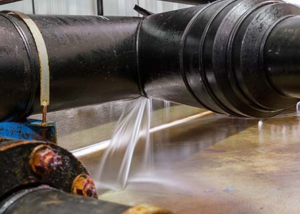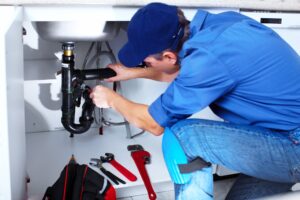A gas leak is a serious problem that can have catastrophic effects. Not only does it cause damage to your home, but it can also pose a health hazard for the residents of your house.
Fortunately, Gas Leak Repair New York can detect and address these problems. One method involves a simple mixture of soap and water. Simply spray or brush the mixture over any suspected areas of leaking gas and look for bubbles to form.

Gas leaks are dangerous and need to be dealt with immediately. They can quickly become a fire or explosion if they are not properly handled, and can also be an asphyxiation risk for anyone who is trapped inside. There are several ways to identify a gas leak, including the smell of rotten eggs or sulfur, dead house plants near the lines, and sparks or flames near the line. If you notice any of these symptoms, evacuate the area right away and call a professional plumber for emergency services.
Identifying the location of a gas leak can be difficult, especially if it is underground or in a wall. However, a professional plumber will be able to locate and repair the leak in a timely manner. If the leak is in a pipe that runs underground, a technician can usually find it by listening for distinct sounds. These sounds may include hissing or dripping noises. This sound can indicate a crack in the pipe, which allows natural gas to escape.
Leaks in gas lines can be caused by natural wear and tear on old pipes, or man-made mistakes during installation or repairs. In many cases, these leaks occur where pipes join together at fittings such as shut off valves, tees, unions, flexible supply lines, and regulators. These fittings are often exposed to weather and other environmental conditions that can cause corrosion, and also can be impacted by soil shifts or erosion.
A professional plumber will be able to inspect the entire gas line system for these signs of damage and repair or replace any parts as needed. This includes the main line from the utility company, and any pipes that run between houses and other buildings on the property. The plumber will be able to identify any areas of concern and provide recommendations for repairs or replacement.
If you have a confirmed gas leak, you should evacuate the area and leave the doors open for ventilation. This will prevent any accidental ignition of the escaping gas, and will give a professional time to find and fix the leak. Do not try to make any last-minute chores around the house, such as washing laundry or completing phone calls.
Over time, natural gas pipes may develop cracks and other damage that creates leaks. If you notice this damage, it is important to have a professional inspect and repair the line as soon as possible. If left untreated, a gas leak can eventually result in an explosion and other severe property damage.
The first step in repairing a gas line leak is to shut off the gas supply. This is usually done by turning off the valve located at your home’s gas meter. Once the gas is turned off, call a plumber to help you get it fixed as soon as possible.
One of the main signs that you have a gas leak is the smell. If you notice a strong, rotten odor in your home, it is likely that there is a gas leak somewhere nearby. Another way to check for a gas leak is by listening. Leaking gas often causes a hissing noise. Larger leaks can also produce whistling or roaring sounds.
If you hear or see any of these warning signs, you should evacuate your home immediately. Don’t try to find the source of the leak yourself. This could expose you to dangerous levels of carbon monoxide. It is best to leave the situation to the professionals.
While evacuating, you should avoid using any electronic devices in your home. These can cause sparks that may ignite the leaking gas. You should also open windows and doors to let in as much air as possible. This won’t stop the leak, but it can help reduce the amount of gas that accumulates inside your home.
When you do finally decide to fix your leaking gas line, you should start by purchasing a new pipe. Be sure to choose a pipe that is rated specifically for use with natural gas. Next, you should prepare the new pipe before installing it. Start by wrapping four layers of Teflon tape around the male pipe threads. After this, coat the threads with pipe dope or pipe-joint compound. Once this is finished, screw the new pipe onto the connectors and tighten it with a wrench.
It is important to recognize the signs of a gas leak and have it repaired as soon as possible. This can help prevent health problems, property damage, and even fires. While most people associate a gas leak with foul sulfur or rotten egg odors, there are a number of other indicators that it may be time to call a plumber. These include dead houseplants, hissing noises near appliances or connections, and increased utility bills. It is also important to regularly inspect your home and gas-powered equipment for any physical damage.
If any of these signs are present, it is essential to evacuate the area immediately and contact emergency services from a safe distance. It is important to remember that a serious gas leak can cause asphyxiation by replacing the oxygen in the bloodstream, so it’s vital not to remain in the affected area for any length of time. The other major danger is that a small spark can ignite the gas, which could lead to an explosion or fire.
A professional plumber will have the necessary equipment and tools to safely locate and repair a gas leak. They will use a series of steps to ensure that the leak is fixed and can be tested for any remaining issues before returning the gas supply to the home. The plumber will also replace the covers that were removed to perform repairs and make sure everything is working as it should.
When looking for a plumber to repair your gas leak, it is best to work with one who specializes in this type of service. They will have the tools and experience necessary to get the job done quickly and correctly. In addition, they will be familiar with all local codes and regulations, which will ensure that your home is safe.
While you can take steps to reduce the risk of a gas leak, it’s essential to understand the dangers and act accordingly when you do have a problem. Regular inspections and hiring a professional plumber will ensure that your leak is repaired as quickly as possible to protect your health, your property, and the environment.
If you have a gas line leak, it’s important to contact a professional to handle the repair. The process can be dangerous and requires a lot of knowledge and precision. It is also a task that should not be undertaken by homeowners, as there are serious consequences if the repair is not done properly.
The first step is to turn off the gas. This is crucial as you will be working with high pressure and could inhale the natural gas, which can be toxic. Then, remove the plastic covers from around the pipes and put on a gas mask and gloves for safety. After the gases are off, remove the low pressure gas line from the regulator and release any excess gas pressure by cracking the pipe fittings with a wrench.
Once the pipes are disconnected, you will need to clean them thoroughly using acetone to remove any impurities that can cause future leaks. You may need to replace some of the metal parts on the pipe as well, depending on where the leak is located and what type of repair it needs. After cleaning the pipes, you will need to reinstall the covers. After the gas lines are reinstalled, it’s important to test them again to make sure that they are free of any leaks.
A hissing sound may indicate a gas leak, but it could also mean that the gas line has a loose connection or a broken seal. It is best to shut off the gas line and call a licensed repair professional as soon as possible when you hear this noise.
Other signs of a gas leak include the smell of rotten eggs, water that bubbles in toilets and bathtubs, dead houseplants, and higher than usual gas bills. The cost of repairing a gas line can vary from as little as $100 to $800, depending on how big the leak is and what sort of repair is needed.
Most gas line repairs are completed by professionals, as they require special tools to get to the problem areas. These professionals can also inspect the entire system with a camera to see what caused the leak and how it can be fixed. In some cases, the entire pipe may need to be replaced, and this can add to the overall repair costs.

